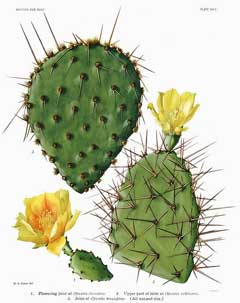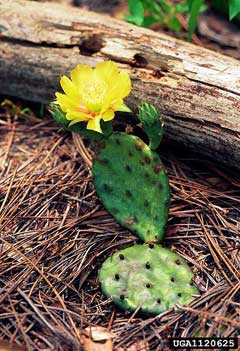 |
|
http://commons.wikimedia.org/wiki/File:Opuntia13_filtered.jpg |
 |
| www.invasive.org |
Translate this page:
Summary
Bloom Color: Yellow. Main Bloom Time: Late summer, Mid summer. Form: Spreading or horizontal.
Physical Characteristics

 Opuntia is an evergreen Perennial growing to 0.2 m (0ft 8in) by 1 m (3ft 3in) at a fast rate.
Opuntia is an evergreen Perennial growing to 0.2 m (0ft 8in) by 1 m (3ft 3in) at a fast rate.
See above for USDA hardiness. It is hardy to UK zone 4 and is not frost tender. It is in leaf all year, in flower from July to August. The species is hermaphrodite (has both male and female organs) and is pollinated by Insects.
Suitable for: light (sandy) and medium (loamy) soils and prefers well-drained soil. Suitable pH: mildly acid, neutral and basic (mildly alkaline) soils. It cannot grow in the shade. It prefers dry soil and can tolerate drought. The plant can tolerates strong winds but not maritime exposure.
UK Hardiness Map
US Hardiness Map
Synonyms
O. humifusa. Raf. O. macrarthra. O. opuntia. O. rafinesquii. O. vulgaris.
Plant Habitats
Edible Uses
Fruit - raw, cooked or dried for later use[3, 46, 61, 62, 183]. Sweet and gelatinous[85]. Lean and insipid[95]. The unripe fruits can be added to soups etc, imparting an okra-like mucilaginous quality[183]. The fruit can hang on the plant all year round[160]. The fruit is up to 4cm long and 3cm wide[200]. Be careful of the plants irritant hairs, see the notes above on toxicity. Pads - cooked or raw[62, 160]. Watery and very mucilaginous[85]. Seed - briefly roasted then ground into a powder[62]. It is also used as a thickener[62].
References More on Edible Uses
Medicinal Uses
Plants For A Future can not take any responsibility for any adverse effects from the use of plants. Always seek advice from a professional before using a plant medicinally.
A poultice of the peeled pads is applied to wounds, sores etc[222]. The juice of the fruits is used as a treatment for warts[222]. A tea made from the pads is used in the treatment of lung ailments[222].
References More on Medicinal Uses
The Bookshop: Edible Plant Books
Our Latest books on Perennial Plants For Food Forests and Permaculture Gardens in paperback or digital formats.

Edible Tropical Plants
Food Forest Plants for Hotter Conditions: 250+ Plants For Tropical Food Forests & Permaculture Gardens.
More

Edible Temperate Plants
Plants for Your Food Forest: 500 Plants for Temperate Food Forests & Permaculture Gardens.
More

More Books
PFAF have eight books available in paperback and digital formats. Browse the shop for more information.
Shop Now
Other Uses
The following notes are for O. ficus indica. They almost certainly also apply to this species[K]. A gum is obtained from the stem. It is used as a masticatory or can be mixed with oil to make candles[64, 207]. The juice of the boiled stem segments is very sticky. It is added to plaster, whitewash etc to make it adhere better to walls[92].
Special Uses
References More on Other Uses
Cultivation details
Landscape Uses:Alpine garden, Border, Container, Rock garden, Seashore.Requires a sandy or very well-drained soil[160]. Prefers a pH in the range 6 to 7.5[200]. Must be kept fairly dry in winter but likes a reasonable supply of water in the growing season[200]. A position at the base of a south-facing wall or somewhere that can be protected from winter rain is best for this plant. Requires warmth and plenty of sun. Plants tolerate considerable neglect. Plants are very cold-hardy, tolerating temperatures down to about -30°c[160], but they are intolerant of winter wet. There is considerable confusion over the correct name for this species, several of the synonyms listed above are also applied to other species in this genus. Special Features:Attracts birds, North American native, Attractive flowers or blooms. The plant is heat tolerant in zones 12 through 9. (Plant Hardiness Zones show how well plants withstand cold winter temperatures.
Plant Heat Zones show when plants would start suffering from the heat.
The Plant Heat Zone map is based on the number of "heat days" experienced in a given area where the temperature climbs to over 86 degrees F (30°C).
At this temperature, many plants begin to suffer physiological damage. Heat Zones range from 1 (no heat days) to 12 (210 or more heat days).
For example Heat Zone. 11-1 indicates that the plant is heat tolerant in zones 11 through 1.) For polyculture design as well as the above-ground architecture (form - tree, shrub etc. and size shown above) information on the habit and root pattern is also useful and given here if available. A clumping mat former. Forming a dense prostrate carpet with a limited spread [1-2]. The root pattern is fibrous dividing into a large number of fine roots [1-2].
References Carbon Farming Information and Carbon Sequestration Information
Temperature Converter
Type a value in the Celsius field to convert the value to Fahrenheit:
Fahrenheit:
The PFAF Bookshop
Plants For A Future have a number of books available in paperback and digital form. Book titles include Edible Plants, Edible Perennials, Edible Trees,Edible Shrubs, Woodland Gardening, and Temperate Food Forest Plants. Our new book is Food Forest Plants For Hotter Conditions (Tropical and Sub-Tropical).
Shop Now
Plant Propagation
Seed - sow early spring in a very well-drained compost in a greenhouse. When they are large enough to handle, prick the seedlings out into individual pots and grow them on in the greenhouse for at least their first two winters. Plant them out into their permanent positions in late spring or early summer, after the last expected frosts. Give the plants some protection from winter wet. Make sure you have some reserve plants in case those outdoors do not overwinter. Cuttings of leaf pads at any time in the growing season. Remove a pad from the plant and then leave it in a dry sunny place for a couple of days to ensure that the base is thoroughly dry and has begun to callous. Pot up into a sandy compost. Very easy, rooting quickly.
Other Names
If available other names are mentioned here
Native Plant Search
Search over 900 plants ideal for food forests and permaculture gardens. Filter to search native plants to your area. The plants selected are the plants in our book 'Plants For Your Food Forest: 500 Plants for Temperate Food Forests and Permaculture Gardens, as well as plants chosen for our forthcoming related books for Tropical/Hot Wet Climates and Mediterranean/Hot Dry Climates. Native Plant Search
Found In
Countries where the plant has been found are listed here if the information is available
Weed Potential
Right plant wrong place. We are currently updating this section.
Please note that a plant may be invasive in one area but may not in your area so it’s worth checking.
Conservation Status
IUCN Red List of Threatened Plants Status :

| Related Plants
|
| Latin Name | Common Name | Habit | Height | Hardiness | Growth | Soil | Shade | Moisture | Edible | Medicinal | Other |
| Cylindropuntia spp. | Cholla | Perennial | 2.0 |
8-12
| S | LMH | SN | D | 3 | 0 | 4 |
| Opuntia compressa | Eastern Prickly Pear, Prickly Pear Cactus | Perennial | 0.2 |
8-10
| F | LM | N | D | 3 | 1 | 2 |
| Opuntia dillenii | Dillen prickly pear, | Perennial | 1.0 |
10-12
| M | LM | N | DM | 3 | 0 | 3 |
| Opuntia erinacea | Mojave Prickly Pear | Perennial | 0.5 |
8-11
| | LM | N | D | 2 | 0 | 2 |
| Opuntia ficus-indica | Prickly Pear, Barbary fig | Perennial | 5.0 |
8-11
| | LM | N | D | 3 | 2 | 3 |
| Opuntia fragilis | Prickly Pear, Brittle pricklypear | Perennial | 0.1 |
7-10
| | LM | N | D | 2 | 1 | 2 |
| Opuntia howeyi | | Perennial | 0.0 |
-
| | LM | N | D | 2 | 0 | 2 |
| Opuntia imbricata | Tree Chola | Perennial | 3.0 |
8-11
| | LM | N | D | 2 | 0 | 2 |
| Opuntia littoralis | Western Prickly Pear | Perennial | 0.6 |
-
| | LM | N | D | 2 | 0 | 2 |
| Opuntia macrorhiza | Twist-Spine Prickly Pear | Perennial | 0.1 |
8-11
| | LM | N | D | 2 | 0 | 2 |
| Opuntia microdasys | Bunny Ears, Angel's-wings | Perennial | 0.6 |
7-10
| | LM | N | D | 2 | 0 | 2 |
| Opuntia phaeacantha | Bastard Fig, Tulip pricklypear | Perennial | 0.5 |
8-11
| | LM | N | D | 2 | 1 | 2 |
| Opuntia polyacantha | Plains Prickly Pear, El Paso pricklypear, Grizzlybear pricklypear, Navajo Bridge pricklypear, Hairsp | Perennial | 0.2 |
3-7
| | LM | N | D | 3 | 1 | 2 |
| Opuntia ramosissima | Branched Pencil Cholla | Perennial | 0.6 |
7-10
| | LM | N | D | 3 | 0 | 2 |
| Opuntia tomentosa | Velvet prickly pear, Woollyjoint Pricklypear | Perennial | 4.5 |
9-12
| M | LM | N | DM | 3 | 0 | 3 |
|
Growth: S = slow M = medium F = fast. Soil: L = light (sandy) M = medium H = heavy (clay). pH: A = acid N = neutral B = basic (alkaline). Shade: F = full shade S = semi-shade N = no shade. Moisture: D = dry M = Moist We = wet Wa = water.

Expert comment
Author
(Salisb.)J.F.MacBr.
Botanical References
200274
Links / References
For a list of references used on this page please go here
Readers comment
| Add a comment |
|
If you have important information about this plant that may help other users please add a comment or link below. Only comments or links that are felt to be directly relevant to a plant will be included. If you think a comment/link or information contained on this page is inaccurate or misleading we would welcome your feedback at [email protected]. If you have questions about a plant please use the Forum on this website as we do not have the resources to answer questions ourselves.
* Please note: the comments by website users are not necessarily those held by PFAF and may give misleading or inaccurate information.
To leave a comment please Register or login here All comments need to be approved so will not appear immediately.
|
|